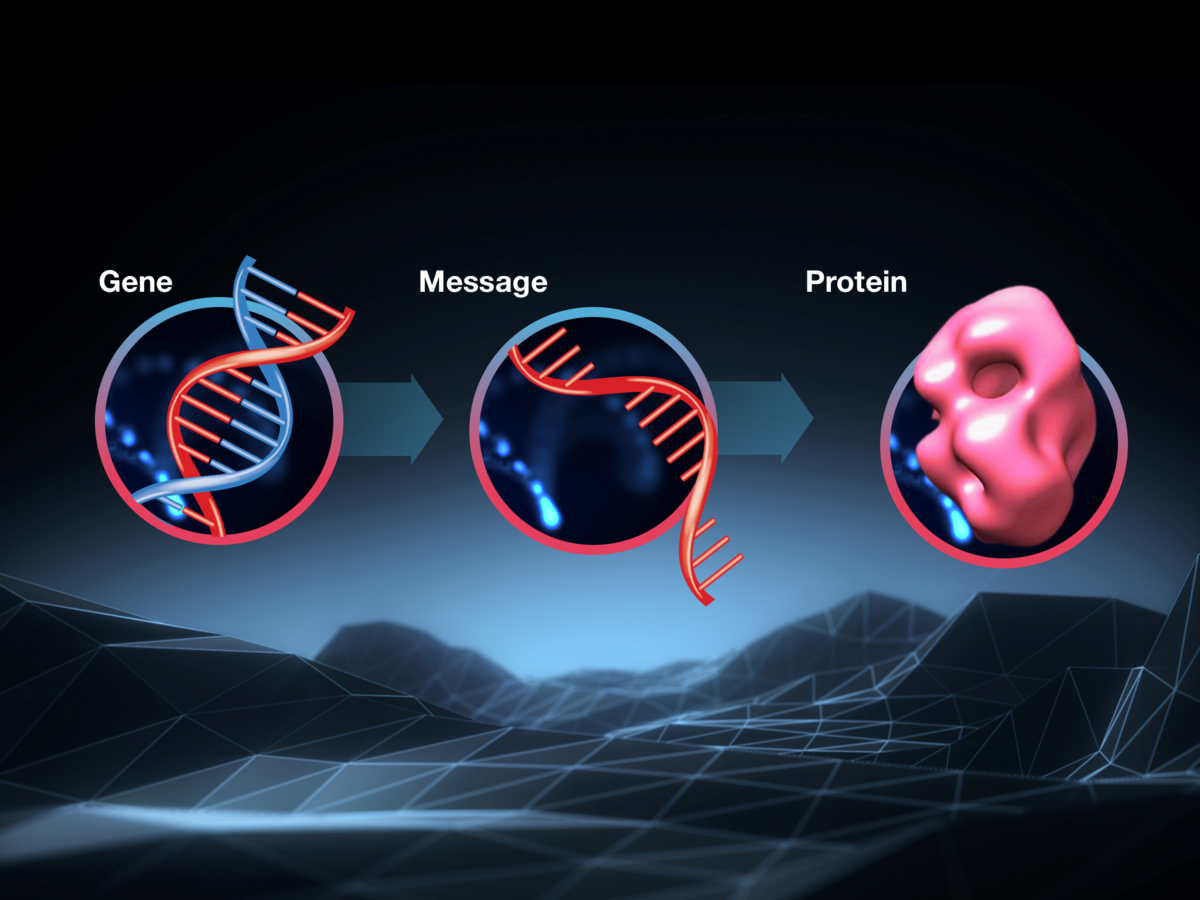A powerful message: does a toxic RNA message molecule cause harm in Huntington's disease?
What if some problems in HD were due to something other than a harmful protein?
 By Dr Jeff Carroll December 23, 2016 Edited by Professor Ed Wild
By Dr Jeff Carroll December 23, 2016 Edited by Professor Ed Wild
Researchers have long believed that the Huntington’s disease gene causes problems by telling cells to make a harmful protein. Intriguing new animal work from researchers in Spain suggests we might want to look at more than one suspect to completely fix the problems caused by the HD mutation.
The central dogma of biology
Every Huntington’s disease patient carries the same basic genetic mutation, inherited from either their mother or their father. This mutation is in a gene we mostly just call the HD gene to keep things simple.

The mutation that causes HD is an expansion of an already repetitive stretch of DNA in the HD gene. Near one end of the gene we find the genetic letters C-A-G repeated over and over. In people without Huntington’s disease, their HD genes have about 20 repetitions of this CAG sequence. However, if you inherit a copy of the HD gene with more than 39 repeats, Huntington’s Disease will develop at some point in your life.
Genes are used by cells as instructions, or recipes, to create proteins. Proteins are the machines that make cells work. All the cool stuff our cells can do depends on the intricate interaction of the thousands of different proteins whizzing and whirling away inside each cell.
Between the instructions in our genes, and the proteins doing stuff all over our cells, there is an intermediate step. Because DNA is so important and has to be protected at all costs, when a cell needs a copy of a specific protein, the cell copies the instructions into a fresh molecule called RNA.
Because they carry information from one place in the cell to another, scientists call these working copies ‘messenger RNA’ or mRNA.
Whenever mRNA is floating around, the cell will read it and follow its instructions to make the corresponding protein. This sequence – gene, mRNA, protein – is how the manufacturing of proteins is achieved and controlled in all cells. It’s so fundamental that it’s sometimes called the 'central dogma of biology’.
Who’s the bad guy?
Which of these players is the bad guy? Most scientists working on HD believe it’s the mutant protein, not the gene or the messenger, that causes most of the problems in the cells of people with the Huntington’s disease mutation. And there’s a ton of evidence that the protein is to blame for many things that go wrong in cells with the HD mutation. But is that the whole picture?
In some other genetic diseases, the messenger molecule itself is the main cause of problems. One example is a disease called myotonic dystrophy, which is also caused by too many repeats of a three-letter genetic sequence. In myotonic dystrophy, message molecules with long repeats causes cells to work incorrectly and ultimately die – it’s the mRNA that’s to blame, not the corresponding protein.
There has long been a group of scientists who believe that the messenger might be harmful in Huntington’s disease, too. New work from a group in Spain suggests these think-outside-the-box researchers might be on to something.
Early work in cells
In 2012, a group of researchers led by Eulalia Marti from the University of Barcelona described some very interesting work with the HD gene messenger. They discovered that messenger molecules from mutant HD genes – the kind found in people who develop Huntington’s disease – could be toxic to cells growing in the lab. Messenger molecules from normal genes were not toxic to cells.
That was surprising, because the team had been careful to make sure the messenger molecules they were studying could not actually instruct the cell to make mutant protein. They also did some detailed follow up experiments and identified some of the key players in the cell that cause the messenger to be toxic.
But, just because something can happen in cells in a dish, doesn’t mean it does happen in living brains, so Marti’s team next turned their attention to a mouse model of Huntington’s disease, and brains of actual HD patients. In sick regions of the brains of both mice and people, they found evidence of toxic pieces of the HD gene messenger molecule. When they carefully eliminated all the proteins and other stuff from these real brains, leaving just the messenger molecules, they found that these messenger molecules made healthy cells in the lab become sick.
This is pretty good evidence that something interesting is happening with the messenger molecule of the HD gene, and that it’s very possible some of the reasons cells get sick in HD could be cause by stuff other then the mutant protein.
“This new study uses a clever way to demonstrate that the messenger might be harmful, and that harm might be important. ”
New work in mice
Recently, Marti’s team has published a very interesting followup study suggesting they may be on to something important. This new study uses a clever way to demonstrate that the messenger might be harmful, and that harm might be important.
Marti and her team thought up a way to stop the HD gene messenger molecule from being toxic, without changing the levels of the protein made from the HD gene. In other words, the messenger is still there, and can still be read by the protein-making machinery, but it is no longer able to cause harm directly.
Surprisingly, they found a way to do just this, using something called an antisense oligonucleotide, or ASO.
If you’re already familiar with ASOs, it’s probably because they’re currently being tested in human patients with Huntington’s disease as a potential therapy. In general, the job of ASOs is to find their way into cells and stick to messenger molecules.
The ASOs currently being tested in humans, made by Ionis Pharmaceuticals, stick to the HD gene messenger molecule, and target it for destruction. Less message means less protein — and we hope that will protect cells from harm. The approach is called huntingtin lowering or sometimes gene silencing.
But the ASOs used by Marti and her colleagues work in a subtly different way. They enter cells and find the HD messenger molecule, but once they find it, they just stick it it and hang out there. No destruction of the HD messenger, and so no change in the levels of the protein using from the message.
Why would we want such a useless ASO? Because, Marti’s team found that by binding to the HD gene message, the toxic effects of the message that they had mapped out in their earlier study were blocked. In short, they found a very cool tool to test the importance of the role played by the HD gene messenger.
When they injected this special ASO into the brains of HD model mice, they found reductions in the toxic messenger effects, but no change in the HD protein, as they’d predicted. Surprisingly, they found that while there was still a lot of mutant HD protein around, the mice acted much healthier.
What’s this all mean?
This is really cool science, because it’s done very carefully and reminds us that we have to keep questioning our assumptions about how HD works. Any problem as complex as HD is likely to have multiple causes — and it’s totally reasonable that both the messenger and the protein created from the mutant gene could be toxic.
What does this mean for HD therapies, especially the ongoing h untingtin lowering trial of ASOs? We’re not sure yet, but intuitively it makes sense that an ASO of the type being tested by Ionis should be beneficial for both types of toxic effects - those caused by the message and those caused by the protein. Many other approaches to huntingtin lowering would also be expected to get rid of the toxic messenger and protein. And even if some future treatment ‘only’ reduces levels of the protein, we’re still pretty sure that would be a really good thing to do. That’s a relief!
Now that Marti and her team have shown the way, researchers in the future can check how any new proposed therapy affects both possible kinds of toxicity caused by the HD mutation.


